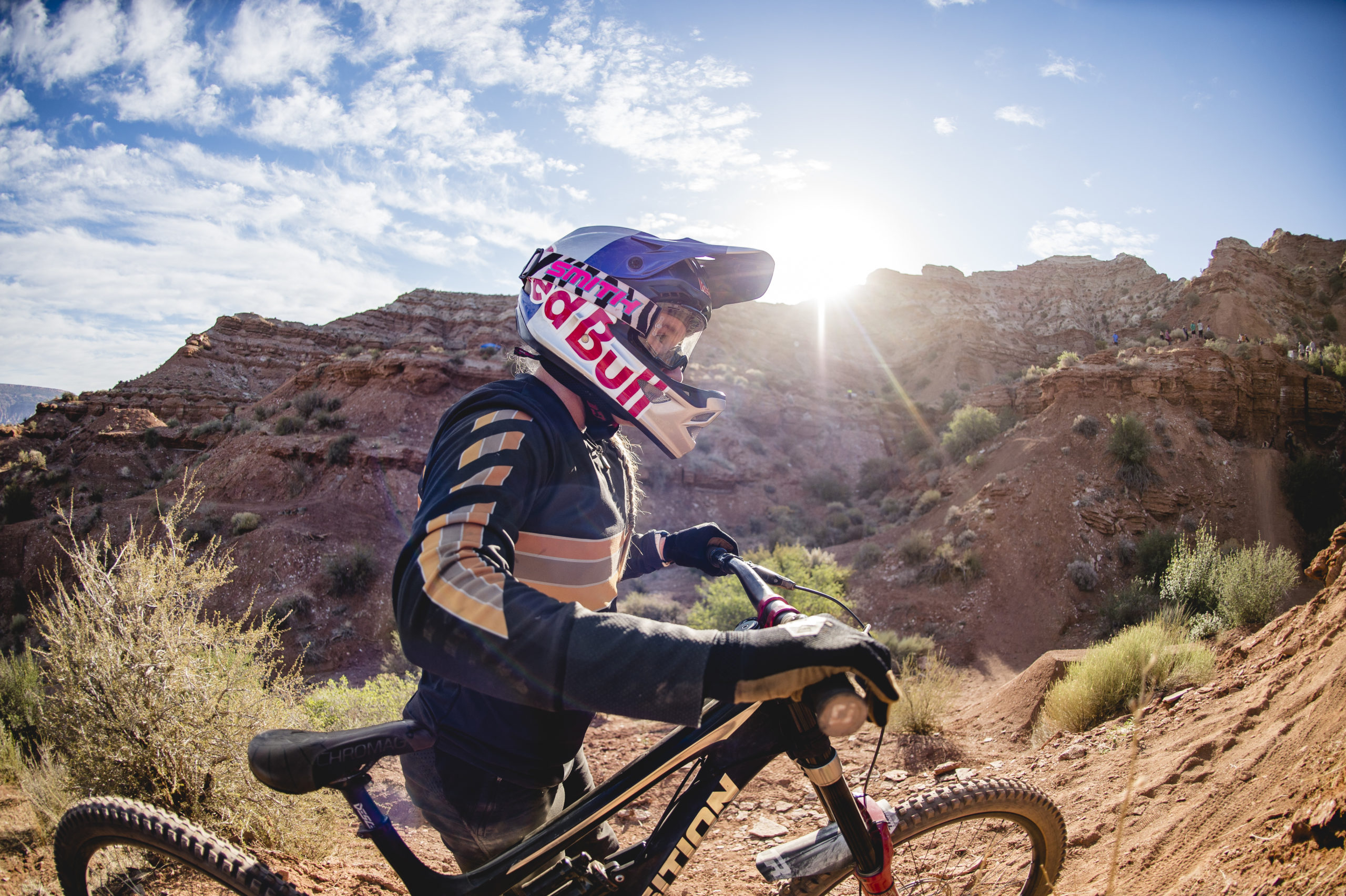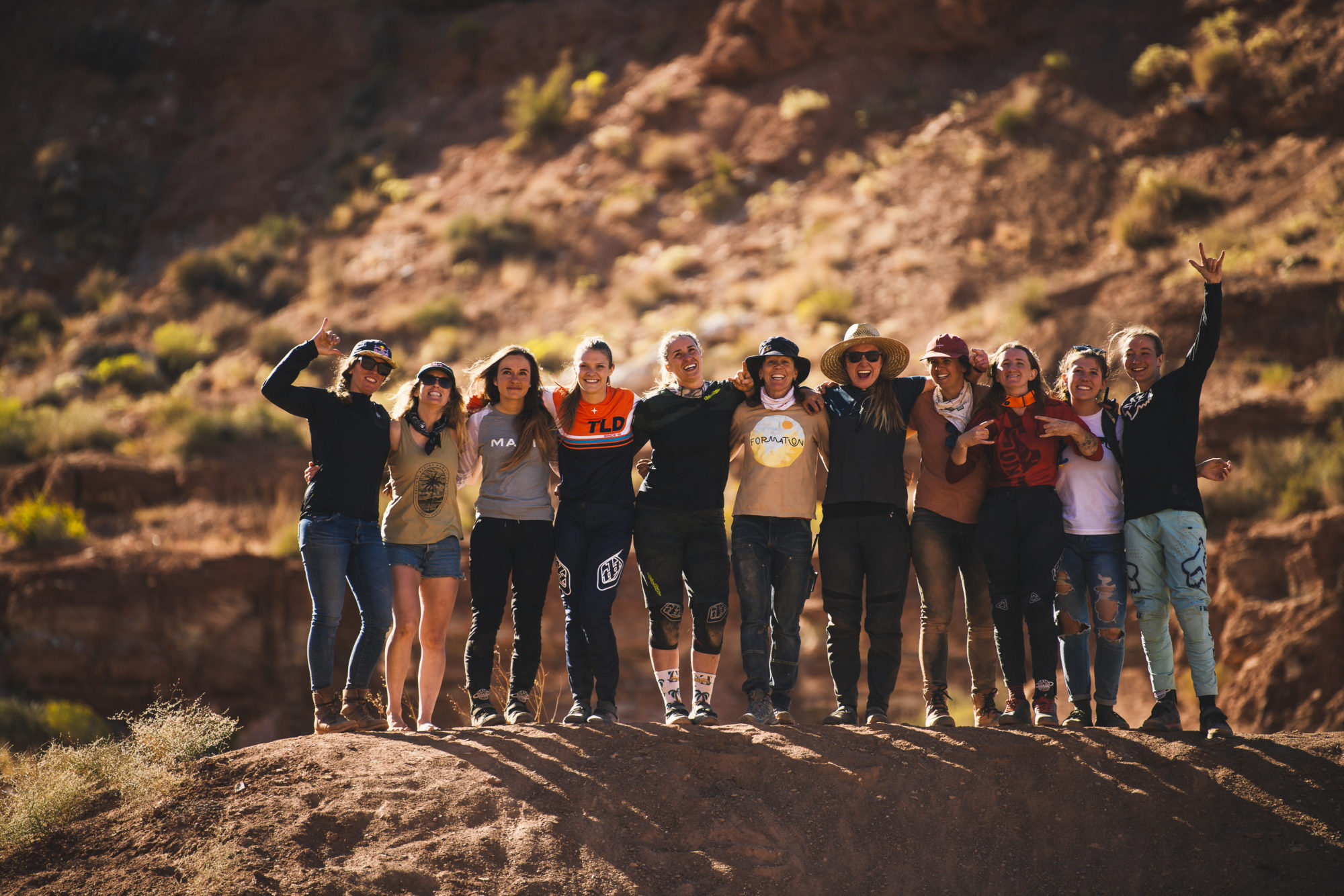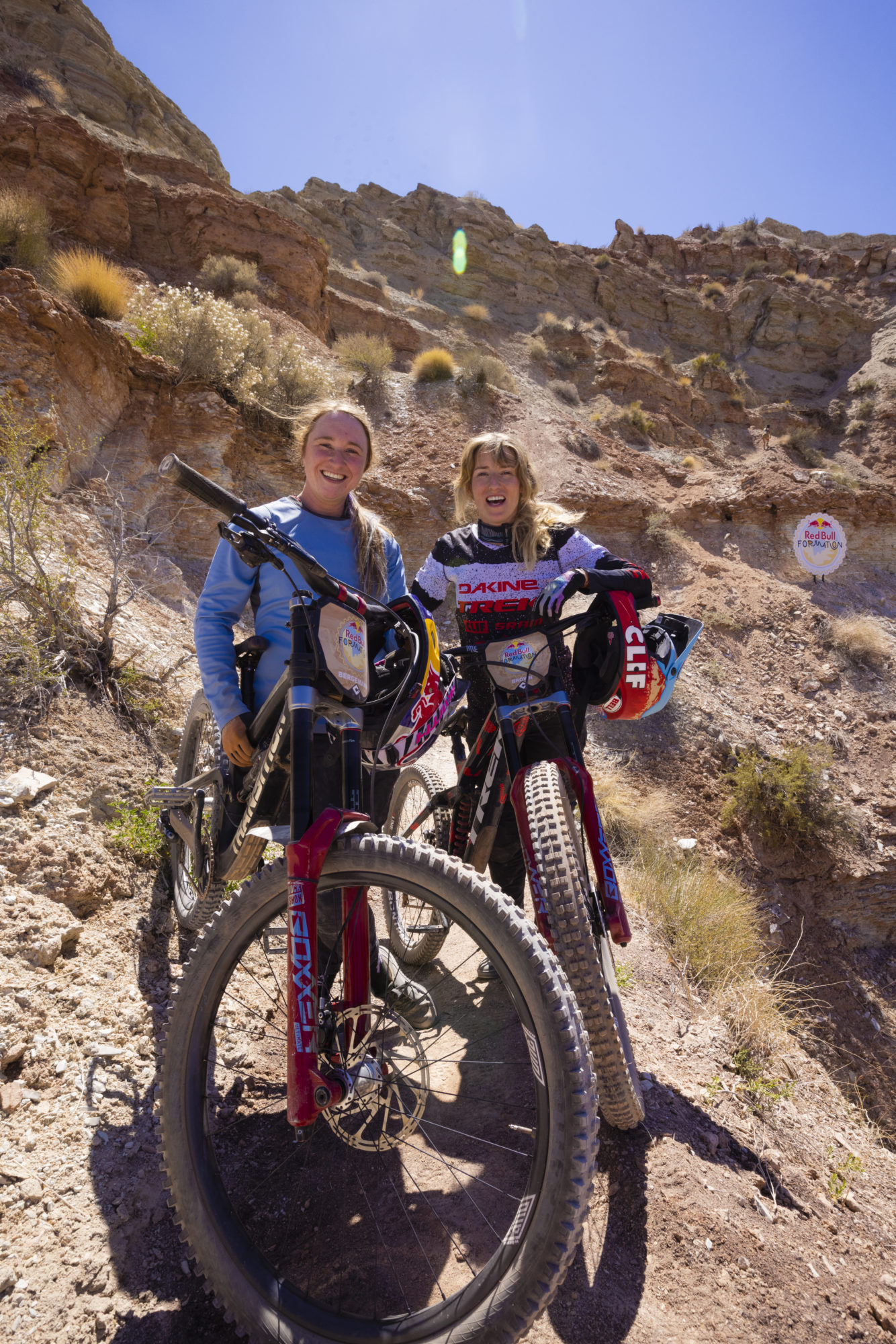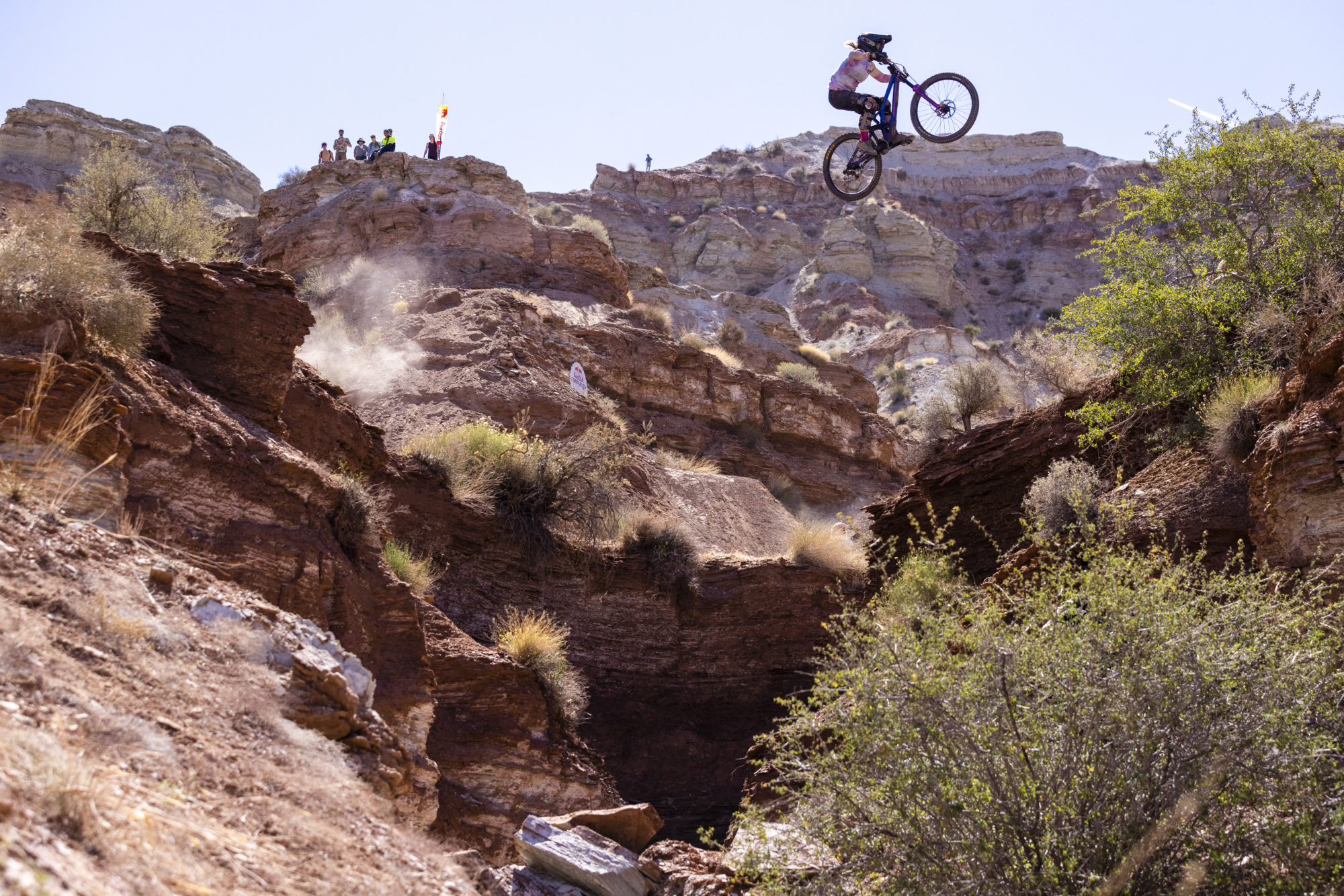
Red Bull Formation is the future of women’s sports
About ten years ago, Katie Holden headed to Virgin, Utah, eager to dig in—literally—to what she hoped would be her career path. With a shovel and pick, Holden spent hot, grueling days helping dig lines for the athletes who would drop down white-knuckle, red-rock cliffs at Red Bull Rampage, freeride mountain biking’s premier competition.
At the time, the cadre of Red Bull Rampage competitors were all male. But Holden, an up-and-coming mountain bike racer and perennial goal-setter, could envision a future where she and other women were digging their own lines at Red Bull Rampage. Determined to get there, she volunteered every year as a digger. “I thought if I ever wanted a shot at doing this, I needed to surround myself by everyone that’s doing it—be a part of it, be a sponge, and learn as much as I possibly can,” she says.
Fast forward to 2021, and Red Bull Rampage is still a men’s-only event. Competitors are selected based mainly on recent performance and reputation, a subjective process that, to date, continues to favor the guys. But Holden—whose own professional trajectory has included a series of injuries, setbacks, and resilient metamorphosis—hasn’t let that lack of gender parity hold her back.
In fact, she and a community of bad-ass women, supportive men, and progressive sponsors like Red Bull have carved an all-new line for women in the freeride world.
More on that in a minute.

Where the girls at?
Gender parity has been an uphill battle since, well, at least 8th century BC with the dawn of the Greek Olympics.
Back in Olympia, women weren’t allowed to compete in the games, and legend has it that married women weren’t even allowed to watch the competitions (Perhaps to protect their delicate nature, as the male athletes were required to compete sans clothing, allegedly to prove they were males?).
The first modern Olympic games in 1896 didn’t allow female athletes either, but four years later, 22 ladies (making up a paltry two percent of the nearly 1,000 athletes) were permitted to compete for the first time in—wait for it—croquet, tennis, sailing, equestrianism, and golf.
But times have changed, and progress has been made. Last summer, the Tokyo 2020 Olympic and Paralympic Games marked the biggest milestone in gender parity yet. Nearly 49 percent of the athletes participating were women, with the International Olympic Committee claiming these the “first gender-balanced Games in history.”
So what is the future of how gender impacts sports? A continuation of men’s and women’s segregated sports, with the addition of more events for females? An increase in mixed-gender sports? And what about non-binary and trans athletes (especially considering there are currently bans against trans females in women’s competitions in 10 US states)?
A league of her own
Over time, sports that have been historically entrenched in men’s-only competitions have made room for women with the addition of female leagues, teams, and events—albeit with typically less-than-equal funding, media coverage, and salaries.
The men’s National Basketball Association, for example, began in 1946 with 11 teams and now has 30. The highest-paid player (Stephen Curry) currently earns more than $45 million a year. It took 50 years for women to get their own league—The Women’s National Basketball Association kicked off its first season in 1997 with eight teams. Having recently celebrated its 25th season, the league has grown to just 12 teams. And the highest-paid players’ 2021 salaries were $221,430 (in case you’re curious, that’s 0.5 percent of Curry’s take-home pay).

Major League Soccer held its first games in 1996 with ten teams and has grown to 27 total. Seventeen years later, the National Women’s Soccer League launched its first season. As the successor to two defunct female leagues, the NWSL started with eight teams in 2013. In 2022, the league will go from 10 teams to 12.
With its home field in Los Angeles, Angel City Football Club is one of the two expansion teams kicking off in 2022. Its ownership is loaded with influential women, including Natalie Portman, Eva Longoria, Jennifer Garner, Billie Jean King, Jessica Chastain, Serena Williams, and soccer stars Julie Foudy, Abby Wambach, and Mia Hamm.
To augment surprisingly low NWSL salaries (the 2021 minimum salary was just $21,000, compared to $63,547 for MLS’ lowest-paid Reserve Minimum Salary players), Angel City is implementing a revenue-sharing bonus that will evenly split 1 percent of home-game ticket sales among its players.
However, progress for women has been slower in some sports like cycling. The premier men’s-only Tour de France had its inception in 1903. The event added a women’s competition for a brief stint in the 80s, but women have largely been excluded from the competition for over 100 years—a run that will end in 2022 with the debut of the Tour de France Femmes avec Zwift.
The upcoming women’s event has already been criticized for inequities in race days, distances, air time, and prize money (50,000 euros for the winner of the women’s race vs. around 500,000 euros for the men’s). Despite those differences, the event is primarily seen as a long-awaited step in the right direction.
Mixing it up
Another answer to the gender parity question is the rise of mixed-gender events. The Tokyo 2020 Games doubled the number of mixed-gender events over the 2016 Games in Brazil, bringing the total to 18 events.
While sports like equestrianism have featured mixed events since the 1960s, brand new to mixed-gender competitions were swimming (the 4 x 100 medley), track and field (the 4 x 400), shooting (with three events), table tennis, judo, and the triathlon.
For trans athletes at the Olympics, more inclusiveness is on the horizon. In November 2021, the International Olympic Committee updated its guidelines for trans and intersex athletes, with an emphasis on privacy, no presumption of advantage, evidence-based requirements, and more.
Changing the rules
But what about the disrupters looking to rewrite gender parity solutions from a different vantage point, reframing how female athletes can capitalize on their skills and talent?
Athletes Unlimited launched the first of its women’s sports concepts in 2020, with a professional female softball league that breaks the typical pro league rules. All games are played in one location, and competitors live nearby for the short six-week season. There are no team owners, no city-based teams, and no static rosters. Players participate in the profits and decision-making.
Taking a cue from the fantasy sports model, the concept forgoes the team-centric approach and focuses instead on the individual players’ performance and brand. Players earn points for team and individual successes, with the top-ranked athletes drafting fresh teams for the coming week. Perhaps most important to the concept, the league collaborates with athletes in digital content and social story-telling.
All of this is designed to help players connect to fluid fans (those drawn to athletes more than teams), appeal to sponsors, and build careers in traditionally challenging ways for female athletes.
The organization’s website underscores its approach: “Athletes Unlimited athletes, already world-class in their sports, want more opportunity, and more control of their careers. So we eliminated team owners and empowered athletes as leaders and decision-makers. By focusing on women’s sports, these athletes have more opportunities, and fans have more access to these exciting games.”
In 2021, Athletes Unlimited added volleyball and lacrosse leagues, with basketball to join the lineup in 2022.

No 1st place, no last place—everyone wins
In yet another daring departure, female athletes are questioning the very necessity of competition itself.
Enter Red Bull Formation, which is essentially a riff on Red Bull Rampage, but with a twist—no competition, only digital and social media exposure. Here, athleticism and achievement are an end to themselves.
The first of its kind, Formation is billed as a “progression session,” with the multi-day event providing elite female freeride athletes a worldwide platform. The brainchild of Holden, Formation came about after a roundtable gathering at Red Bull Rampage 2018. Over the next year, Holden worked with co-founders, collaborators, and the Red Bull team to launch the 2019 inaugural event, featuring six of the biggest names in female freeriding.
With diggers, mentors, and tools by their side, the athletes created their own lines down Virgin, Utah’s intimidating terrain to showcase their skills—streaming on Red Bull TV, YouTube channels, and generating social media and industry buzz. After a pandemic hiatus, Formation returned in 2021 with eight athletes, two alternates, and even more industry attention.
But are competition-free elite sporting events viable? While prize money and rankings aren’t part of the package when considered through the prism of athletes’ opportunity for branding exposure, sponsorship opportunities, and career advancement (which competitive events also largely provide), the answer is promising.
“Before Formation, a lot of people had the assumption that women didn’t have the skill set to ride the terrain down in Virgin, Utah,” says Formation athlete Hannah Bergemann in an event video. “That assumption came from the lack of representation of women riding there, not from a lack of skill.”
In an interview via Zoom from her home in Washington, Holden adds, “Up until a couple of years ago, freeride hasn’t been a viable career path for a lot of women. There are some outliers like Casey Brown, Vero Sandler—I did it for a while—but maybe just one or two at a time in the whole industry.
“Now having [Formation’s] platform and exposure, having it as a launching pad with a lot of other events now popping up in addition to Formation, it’s a legitimate segment of the industry. Athletes are starting to be sponsored…At the end of the day, I didn’t have what it takes to live that dream of competing at Rampage, but what came out of it with Formation was better than any personal dream I could have ever had.”
And what of all the dreams of up-and-coming athletes? What sports model will they compete (or not compete) in? The story of sports, gender, competition, and career opportunities is still being written—and whether it’s in stadiums, arenas, or on phones, the world will be watching.






